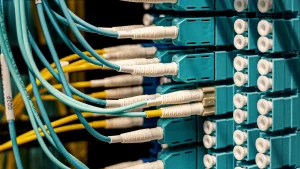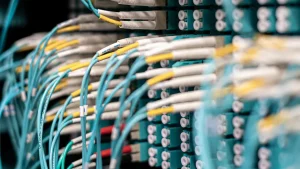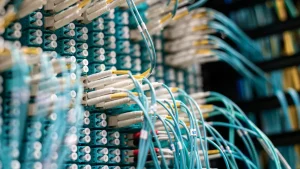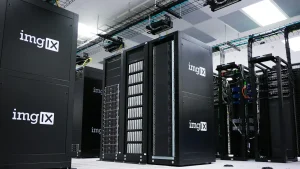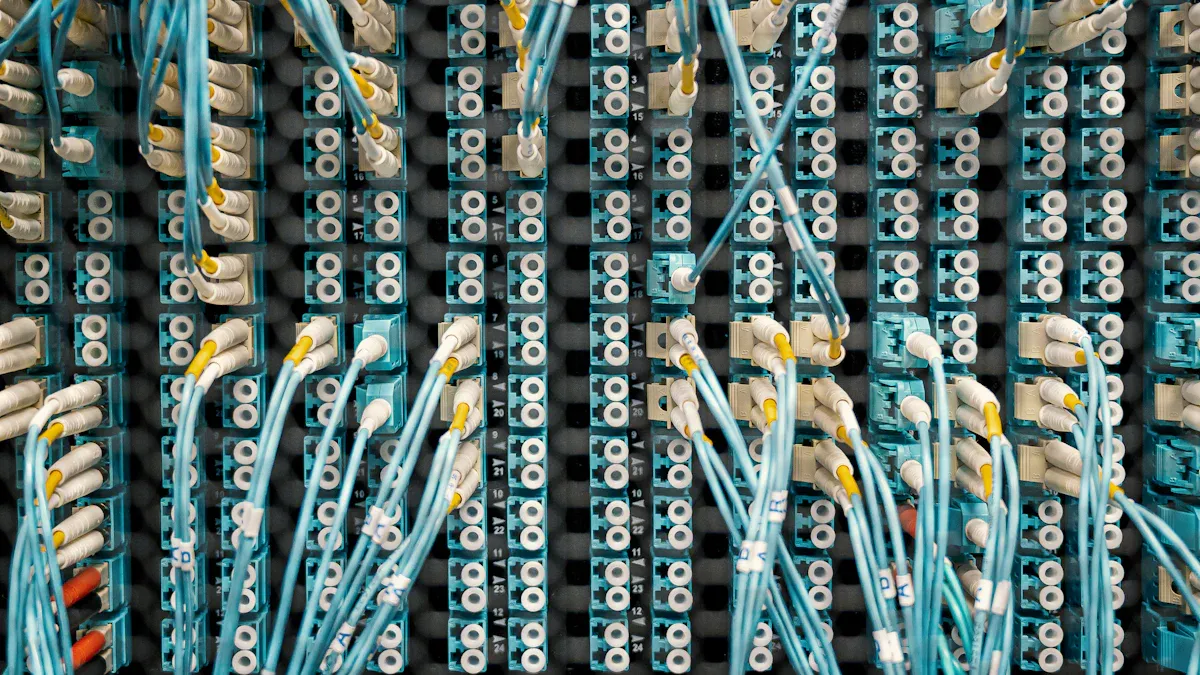
MPO MTP trunk cables, like the 12 Fibers Multimode OM2 MTP/MPO Trunk Cable, and breakout cables serve distinct purposes in networking environments. The 12 Fibers Multimode OM2 MTP/MPO Trunk Cable consolidates multiple fibers into a single unit, enhancing space efficiency. In contrast, breakout cables provide individual connections for each fiber, allowing for flexibility and easy termination. Understanding these differences is crucial, as they directly impact network performance and reliability, ensuring that engineers select the right solution, such as the MPO MTP trunk cable OM2, for their specific applications.
Key Takeaways
- MTP/MPO trunk cables consolidate multiple fibers into one unit, enhancing space efficiency in high-density environments.
- Breakout cables allow individual connections for each fiber, providing flexibility and simplifying network management.
- MTP/MPO trunk cables support high-speed data transmission, making them ideal for data centers and high-bandwidth applications.
- Breakout cables maximize port utilization by connecting a single high-bandwidth port to multiple lower-bandwidth ports.
- Choosing the right cable type depends on specific network needs, future growth plans, and budget considerations.
- MTP/MPO trunk cables reduce installation time and maintenance costs, leading to long-term savings despite higher initial costs.
- Breakout cables are easier to install and manage, making them suitable for dynamic networking environments.
- Understanding the differences between these cables helps engineers select the best solution for optimal network performance.
Understanding MTP/MPO Trunk Cables
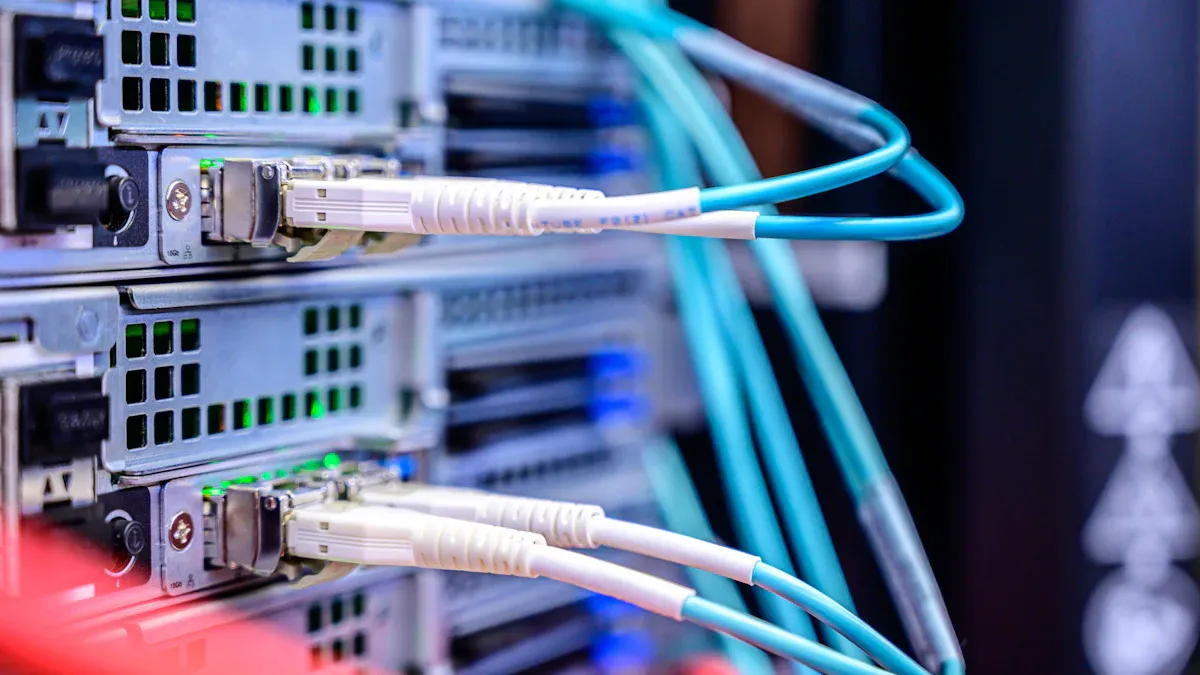
Definition and Purpose
MTP/MPO trunk cables, which stand for Multi-Fiber-Push-On cables, play a crucial role in modern networking. These cables integrate multiple optical fibers into a single compact connector, facilitating efficient data transmission. They serve as the backbone for high-density fiber networks, enabling fast connections within data centers by consolidating numerous connections into one manageable cable system. The primary purpose of MTP/MPO trunk cables includes establishing permanent links between switches or servers, supporting high-speed data transmission, and optimizing space utilization in structured cabling environments.
Key Purposes of MTP/MPO Trunk Cables:
Purpose Description Permanent Link Establishes a fixed connection between switches or servers in a structured cabling environment. High-Speed Data Transmission Supports fast data transfer rates essential for high-density networking. Efficient Space Utilization Reduces installation time and saves pathway space by consolidating multiple fibers under one sheath. Scalability Allows for easy adjustments and expansions using patch cords at the front of patch panels.
Key Features
MTP/MPO trunk cables possess several distinguishing features that set them apart from traditional fiber optic cables. These cables exhibit lower insertion loss, with MTP connectors achieving a range of 0.1dB to 0.35dB compared to MPO’s 0.3dB to 0.75dB. This reduction in signal loss is crucial for maintaining signal integrity over long distances. Additionally, MTP connectors utilize MT ferrules for precise fiber alignment, which is essential in high-density environments.
Key Features of MTP/MPO Trunk Cables:
Feature Contribution to Performance High-density connections Enables more connections in less space, optimizing network layout. Reduced installation time Streamlines setup, allowing for quicker deployment in data centers. Reliable data transmission Ensures consistent performance across various bandwidths. Compact design Minimizes clutter, enhancing airflow and maintenance. Scalability Supports future upgrades to higher bandwidths without major changes.
Benefits of MTP/MPO Trunk Cables
The advantages of using MTP/MPO trunk cables are numerous. They enhance reliability by reducing the need for field terminations, which can introduce errors. The high bandwidth capacity ensures that networks can handle increasing data loads without performance degradation. Furthermore, the design of MTP/MPO cables supports modular upgrades, ensuring long-term reliability as network demands evolve.
Quantifiable Benefits of MTP/MPO Trunk Cables:
Benefit Type Evidence Deployment Time Microsoft’s Azure team reduced deployment time by 60% during its Chicago expansion by using pre-terminated MTP trunk cables. Cost Savings The plug-and-play design eliminates field terminations, cutting labor costs by $8–$12 per port. Bandwidth Capacity MPO cables support high-speed applications like 40G, 100G, and even 400G Ethernet, making them future-proof for growing network demands. Total Cost of Ownership A Tier 3 operator in Singapore reported $2.1 million savings over five years by minimizing reconfiguration downtime. Power Efficiency Facebook’s Altoona data center achieved a 0.12 PUE improvement by adopting MTP-based cabling. Space Efficiency By integrating multiple fibers into a single connector, MPO cables reduce cabling clutter, optimizing rack space and improving airflow in data centers. Ease of Installation The push-on design of MPO cables allows for quick and secure connections, minimizing setup time and labor costs. 5G and Edge Computing Verizon’s 5G mmWave nodes use MTP/MPO pigtails to handle 25Gbps fronthaul links, supporting <1ms latency.
Common Applications
MTP/MPO trunk cables find extensive use across various sectors due to their efficiency and high performance. Their design supports a multitude of applications, making them indispensable in modern networking infrastructures. Below are some of the most common application areas:
| Application Area | Description |
|---|---|
| Data Centers | MTP/MPO trunk cables are essential for managing thousands of servers efficiently. |
| Telecommunications | These cables support high-speed, low-latency connectivity across vast networks. |
| Enterprise Networks | They connect offices, campuses, and remote locations for seamless communication and collaboration. |
| Industrial Automation | MTP/MPO cables support IoT devices, sensors, and smart factory automation, emphasizing reliability and speed. |
In addition to these applications, MTP/MPO trunk cables offer several advantages that enhance their usability:
- Efficient management of large amounts of fiber.
- Support for 40G/100G Ethernet applications.
- Space-efficient designs that reduce rack space in data centers.
The prevalence of MTP/MPO technology is particularly notable in hyperscale data centers and cloud computing environments. These cables are crucial for high-speed data transmission applications, such as 100G and 400G. Their connectors ensure proper alignment between devices, which is critical for reliable data transmission.
Furthermore, MTP/MPO trunk cables excel in high-density fiber patching, significantly reducing cable management issues. They support longer distances compared to Direct Attach Copper (DAC) and Active Optical Cables (AOC), making them suitable for large data centers. Their lower latency and higher signal integrity are vital for applications involving artificial intelligence (AI).
The durability and robustness of MTP/MPO cables reduce the risk of physical damage, simplifying cable management and leading to reduced installation times. Efficient cable management is essential for maintaining reliability and uptime in hyperscale data centers.
Exploring Breakout Cables
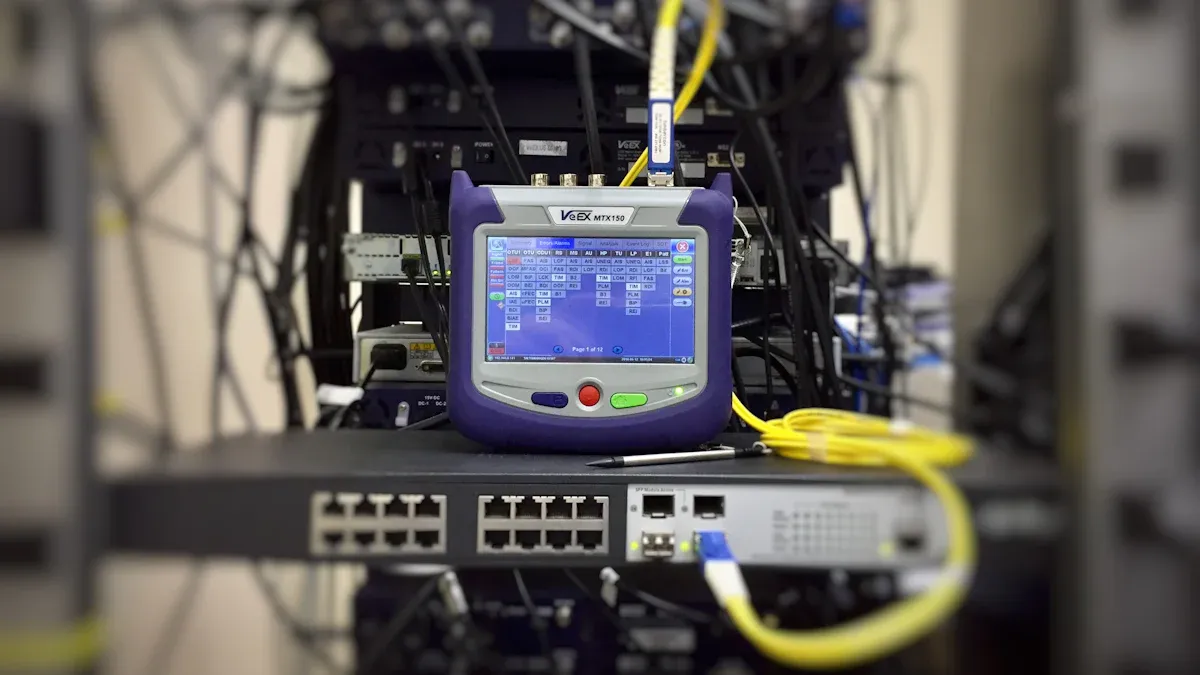
Definition and Purpose
Breakout cables, often referred to as fanout cables, serve a vital role in modern networking. These cables gather multiple optical fibers or electrical pairs into a single jacket that "breaks out" into several individual connectors. This design optimizes network connections and simplifies installation processes. Breakout cables facilitate network connections, simplify network management, and optimize data transmission and bandwidth utilization. Their versatility makes them suitable for various applications, particularly in high-density environments like data centers.
Key Features
Breakout cables possess several key features that distinguish them from MTP/MPO trunk cables. For instance, breakout cables, such as the MPO to 4 LC, effectively split and combine data flow. This capability allows them to convert from 40G to 4x10G and from 100G to 4x25G. Such flexibility in data flow management is a significant advantage over MTP/MPO trunk cables, which typically do not offer this level of adaptability.
Key Features of Breakout Cables:
Feature Description Flexibility Allows for conversion between different bandwidths, accommodating various network needs. Simplified Management Reduces cable clutter and enhances organization in high-density environments. Direct Connections Enables a single high-bandwidth port to connect to multiple lower-bandwidth ports. Compatibility Works seamlessly with various connectors and hardware, minimizing installation complexities.
Benefits of Breakout Cables
The benefits of using breakout cables are numerous and impactful. They maximize port utilization and simplify network cabling in data centers. By enabling direct connections between equipment, breakout cables streamline installations and facilitate easier upgrades and maintenance. Additionally, they allow for greater adaptability to changes in network configurations, making them an essential component in dynamic networking environments.
Quantifiable Benefits of Breakout Cables:
- Breakout cables maximize port utilization and simplify network cabling in data centers.
- They enable direct connections between equipment, simplifying installations and allowing for easier upgrades and maintenance.
- Breakout cables facilitate easier adaptability to changes in network configurations.
In high-density environments, breakout cables play a crucial role by allowing a single high-bandwidth port, such as a 100G or 400G QSFP, to be divided into multiple lower-bandwidth connections. This capability is essential for allocating bandwidth more precisely across various devices, optimizing resource utilization. By using breakout cables with SFP modules, data centers can connect high-bandwidth ports to several lower-bandwidth ports, enhancing cabling management and maximizing available space.
Overall, breakout cables provide a flexible and efficient solution for modern networking challenges, making them indispensable in today’s data-driven world.
Common Applications
Breakout cables serve a variety of essential functions across different networking environments. Their design allows for efficient data transmission and flexible connectivity, making them indispensable in modern infrastructures. Below are some of the most common applications for breakout cables:
| Application Area | Description |
|---|---|
| Data Centers | Breakout cables facilitate data transmission and bandwidth distribution. |
| Communication Networks | They are essential for high-speed data transfer in telecommunication setups. |
| Enterprise Networks | Used to connect switches between different buildings for efficient data flow. |
In addition to these primary applications, breakout cables are frequently utilized in specific network architectures. They enhance panel port density and effectively connect high-speed devices to lower-speed devices in Top-of-Rack (ToR) and End-of-Row (EoR) setups. Here are some key points regarding their use in these architectures:
- Breakout cables are commonly utilized in Top-of-Rack (ToR) and End-of-Row (EoR) architectures.
- They connect high-speed ports to several lower-speed ports, enhancing port density.
- These cables facilitate high data rates over short distances.
Furthermore, breakout DAC cables are ideal for data centers and large-scale environments. They are particularly suited for switch stacks and high-performance computing in ToR and EoR architectures. This versatility allows network engineers to optimize their setups, ensuring efficient data flow and resource utilization.
Overall, breakout cables play a crucial role in enhancing connectivity and performance in various networking scenarios. Their ability to adapt to different configurations makes them a valuable asset in both enterprise and data center environments.
Comparative Analysis of MTP/MPO Trunk Cables and Breakout Cables
Design and Structure
The design and structure of MTP/MPO trunk cables and breakout cables differ significantly. MTP/MPO trunk cables consolidate multiple fibers into a single unit, making them ideal for high-density applications. In contrast, breakout cables separate these fibers into individual connectors, allowing for greater flexibility in network configurations. The following table summarizes the key design features:
| Feature | MTP/MPO Trunk Cables | Breakout Cables |
|---|---|---|
| Fiber Type | Multimode or Singlemode | Multimode or Singlemode |
| Application Type | Parallel Optics OR Duplex | Breakout (Parallel Optics TO Duplex) |
| Applications | 10, 25, 50, 100 Gig (Duplex) 100, 200, 400 Gig (SR4/VR4/DR4/FR4) 800 Gig (SR8/VR8/DR8/FR8) | 4X10, 4X25, 4X50, 4X100, 8X100 Gig |
| Typical Configuration | Permanent Link | Channel or Equipment Connection |
| Connector Type Side 1 | MPO/MTP Connectors | MPO/MTP Connectors |
| Connector Type Side 2 | Same as Side 1 | Multiple duplex connectors |
Performance Metrics
Performance metrics also highlight the differences between these two cable types. MTP/MPO trunk cables typically support higher bandwidths and lower attenuation rates, making them suitable for demanding applications. Conversely, breakout cables excel in scenarios where multiple lower-speed connections are necessary. The following table illustrates these performance characteristics:
| Cable Type | Bandwidth Characteristics | Attenuation Rates |
|---|---|---|
| Singlemode MPO | Higher bandwidth | Lower signal attenuation |
| Multimode MPO | Lower bandwidth | Higher signal attenuation |
Installation Considerations
Installation considerations play a crucial role in selecting between MTP/MPO trunk cables and breakout cables. MTP/MPO trunk cables require careful planning due to their permanent link nature, while breakout cables offer more flexibility during installation. The table below outlines key installation factors:
| MTP/MPO Trunk Cables | MTP/MPO Breakout Cables | |
|---|---|---|
| Fiber Type | Multimode or Singlemode | Multimode or Singlemode |
| Application Type | Parallel Optics OR Duplex | Breakout (Parallel Optics TO Duplex) |
| Applications | 10, 25, 50, 100 Gig (Duplex) 100, 200, 400 Gig (SR4/VR4/DR4/FR4) 800 Gig (SR8/VR8/DR8/FR8) | 4X10, 4X25, 4X50, 4X100, 8X100 Gig |
| Typical Configuration | Permanent Link | Channel or Equipment Connection |
| Connector Type Side 1 | MPO/MTP Connectors | MPO/MTP Connectors |
| Connector Type Side 2 | Same as Side 1 | Multiple duplex connectors |
Cost Comparison
When evaluating MTP/MPO trunk cables and breakout cables, cost plays a significant role in decision-making. Understanding the financial implications of each option helps network engineers choose the most suitable solution for their needs. Below is a breakdown of the costs associated with both cable types.
Initial Investment
The initial investment for MTP/MPO trunk cables tends to be higher than that of breakout cables. This difference arises from the complexity and technology involved in manufacturing MTP/MPO cables. Here’s a quick comparison:
| Cable Type | Estimated Cost per Unit |
|---|---|
| MTP/MPO Trunk Cables | $200 – $500 |
| Breakout Cables | $100 – $300 |
Installation Costs
Installation costs can vary based on the complexity of the network and the specific requirements of each cable type. MTP/MPO trunk cables often require specialized skills for installation, which can increase labor costs. Conversely, breakout cables typically allow for easier installation, reducing labor expenses.
Key Points on Installation Costs:
- MTP/MPO Trunk Cables:
- Require skilled technicians.
- May involve additional equipment for termination.
- Breakout Cables:
- Easier to install.
- Can be managed by general technicians.
Long-Term Savings
While MTP/MPO trunk cables may have a higher upfront cost, they often lead to long-term savings. Their design minimizes the need for frequent maintenance and reduces the risk of errors during installation. This reliability can translate into lower operational costs over time.
Long-Term Savings Considerations:
- MTP/MPO Trunk Cables:
- Lower maintenance costs due to fewer terminations.
- Higher bandwidth capacity supports future upgrades.
- Breakout Cables:
- Lower initial costs but may require more frequent upgrades.
- Potentially higher maintenance costs due to more connections.
How to Choose Between MTP/MPO Trunk Cables and Breakout Cables
Assessing Your Network Needs
When selecting between MTP/MPO trunk cables and breakout cables, understanding specific network requirements is essential. MTP/MPO trunk cables excel in high-speed trunk links, such as 40G, 100G, and 400G, making them ideal for connections between data centers and cabinets. They simplify cabling and save space, which is crucial in high-density environments. Conversely, breakout cables are better suited for splitting high-speed ports into multiple low-speed ports. This flexibility enhances port utilization and allows for seamless connections among various devices.
Evaluating Future Growth
Planning for future growth is vital when choosing the right cable type. Here are some best practices to consider:
- Check Transceiver Type: Understand the requirements for different transceiver types, such as QSFP+, QSFP28, and QSFP-DD, to ensure compatibility with the chosen cable type.
- Plan Migration Path: Determine whether to use trunks for scalable backbones or breakouts for flexible server connections based on anticipated growth needs.
- Evaluate IL/RL Budgets: Ensure that the total channel loss meets IEEE 802.3 specifications to maintain performance.
- Vendor Compatibility: Verify compatibility with vendors like Cisco, Arista, and Juniper to avoid deployment issues.
These considerations help network engineers prepare for evolving demands and ensure that their infrastructure can adapt to future requirements.
Budget Considerations
Budget constraints significantly influence the decision between MTP/MPO trunk cables and breakout cables. The initial investment for MTP/MPO trunk cables tends to be higher due to their advanced technology and manufacturing complexity. However, they often lead to long-term savings by minimizing maintenance needs and reducing the risk of installation errors.
In contrast, breakout cables generally have a lower upfront cost, making them attractive for smaller networks or specific connections. However, they may require more frequent upgrades, potentially increasing long-term expenses.
| Cable Type | Initial Cost Range | Long-Term Considerations |
|---|---|---|
| MTP/MPO Trunk Cables | $200 – $500 | Higher initial cost but lower maintenance costs. |
| Breakout Cables | $100 – $300 | Lower initial cost but may incur higher upgrade costs. |
By carefully evaluating these factors, network engineers can make informed decisions that align with their financial constraints and operational needs.
Technical Expertise Required
Selecting between MTP/MPO trunk cables and breakout cables necessitates a certain level of technical expertise. Network engineers and technicians must understand the specific requirements of each cable type to ensure optimal performance and reliability. Here are some key areas where technical knowledge is essential:
-
Understanding Cable Specifications:
- Engineers must be familiar with the specifications of both MTP/MPO trunk cables and breakout cables. This includes knowledge of fiber types, connector configurations, and bandwidth capabilities.
- Familiarity with standards such as IEEE 802.3 can help engineers make informed decisions.
-
Installation Skills:
- Proper installation of MTP/MPO trunk cables often requires specialized skills. Technicians should know how to handle and terminate these cables correctly to avoid signal loss.
- Breakout cables, while generally easier to install, still require a solid understanding of network topology and cable management.
-
Troubleshooting Abilities:
- Engineers must possess troubleshooting skills to diagnose and resolve issues that may arise during installation or operation.
- Knowledge of testing equipment, such as optical time-domain reflectometers (OTDR), is crucial for identifying faults in fiber optic networks.
-
Network Design Knowledge:
- A comprehensive understanding of network design principles is vital. Engineers should be able to assess current and future network needs, ensuring that the chosen cable type aligns with organizational goals.
- They must also consider factors like scalability, redundancy, and performance metrics when designing network infrastructures.
-
Vendor Compatibility:
- Familiarity with various vendors and their products is essential. Engineers should ensure that the selected cables are compatible with existing hardware and network components.
- Understanding vendor-specific requirements can prevent deployment issues and enhance overall network performance.
Tip: Continuous education and training are crucial for network professionals. Staying updated on the latest technologies and industry standards can significantly enhance their expertise.
In summary, MTP/MPO trunk cables and breakout cables serve distinct purposes in networking. MTP/MPO trunk cables excel in high-density environments, offering efficient data transmission and space-saving designs. Conversely, breakout cables provide flexibility by allowing multiple connections from a single high-bandwidth port.
When selecting the right cable, consider the following:
- Network Requirements: Assess bandwidth needs and connection types.
- Future Growth: Plan for scalability and adaptability.
- Budget: Evaluate initial costs versus long-term savings.
Choosing the appropriate cable ensures optimal network performance and reliability.
FAQ
What is the main difference between MTP/MPO trunk cables and breakout cables?
MTP/MPO trunk cables consolidate multiple fibers into a single unit, while breakout cables separate fibers into individual connectors. This design difference affects their applications and flexibility in network configurations.
When should I use MTP/MPO trunk cables?
Use MTP/MPO trunk cables in high-density environments where space efficiency and high-speed data transmission are critical. They are ideal for connecting switches and servers in data centers.
What are the advantages of breakout cables?
Breakout cables offer flexibility by allowing a single high-bandwidth port to connect to multiple lower-bandwidth ports. They simplify installations and enhance port utilization in various networking scenarios.
Can I mix MTP/MPO trunk cables and breakout cables in my network?
Yes, you can mix both cable types in a network. MTP/MPO trunk cables can serve as the backbone, while breakout cables can connect to individual devices, optimizing performance and flexibility.
How do I determine the right cable type for my network?
Assess your network’s bandwidth requirements, future growth potential, and budget constraints. MTP/MPO trunk cables suit high-density applications, while breakout cables provide flexibility for diverse connections.
Are MTP/MPO trunk cables more expensive than breakout cables?
Generally, MTP/MPO trunk cables have a higher initial cost due to their advanced technology. However, they often lead to long-term savings through reduced maintenance and installation errors.
What installation skills are required for MTP/MPO trunk cables?
Installing MTP/MPO trunk cables requires specialized skills to ensure proper termination and minimize signal loss. Technicians should be familiar with fiber optic standards and installation best practices.
How do I maintain MTP/MPO trunk cables and breakout cables?
Regularly inspect cables for physical damage and ensure connectors remain clean. Proper cable management and adherence to installation guidelines will help maintain optimal performance and longevity.
